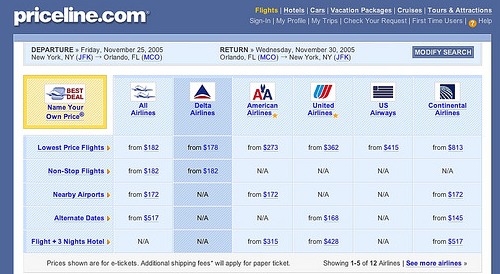The stock price of Priceline.com (PCLN), that inveterate dot.com survivor, is approaching the $1,000 mark. That’s the highest price in the S&P 500 universe. It adds up to a remarkable turnaround at the online travel service known for its wacky advertising featuring William Shatner. The strong market performance raises an intriguing question: Can a stock become too expensive for its own good?

PCLN data by YCharts
Before getting into that discussion, some perspective is in order regarding Priceline. David Gaffen points out the explosive comeback of Priceline, which closed at $928 on August 7, is actually less impressive when one considers the company’s history or reverse splits:
One looks at a $928 share price and would think, “Wow, that’s got to be an all-time high.”But of course, it isn’t. The stock hit a (split-adjusted) $990 a share in April of 1999 before falling to a low of $6 or so a share in October of 2002. Again, this is after a 1-for-6 reverse split in June 2003, so the shares then were more like $1, and it was trying to avoid a delisting. Of course in 1999 that would have made the shares worth more like $160, but just the same, that’s a smile out of a horror movie or something.
The equity market is of course full examples of stocks in nosebleed territory on a per share basis. Berkshire Hathaway A-class shares (BRK.A) closed at about $175,000 per share earlier this week. (It’s not a S&P 500 component stock.) You might argue that’s an extreme case, given that Warren Buffett has never allowed the stock to split, in the effort to attract only long term shareholders and avoid speculators. (Berkshire’s B-class shares (BRK.B) did in fact split on a 50-to-1 basis back in early 2010 to enable an acquisition – the Baby Bs now trade at $116 compared to about $3,500 a pop before the move.)
The Washington Post Company (WPO), which made headlines of its own by selling its flagship newspaper to Jeff Bezos, fetches about $588 per share. Other companies such as Autozone (AZO), Mastercard (MA), and Apple (AAPL) trade in the hefty $400 to $650 per share range. Google (GOOG) commands about $890 a share.
Here’s a full full list of the S&P 500 constituents by price and other metrics.

WPO data by YCharts
To split or not to split is the stuff of a long running debate among traders, analysts and financial academics. Stock splits often occur during flush times and big run-ups in market capitalization, so they can have a big positive psychological impact on existing investors’ sentiment.
Existing shareholders feel happy to see the number of shares they own double in the case of 2-to-1 split. Another plus: A stock that moves from four figures to two can attract new investors who can only buy lower priced stocks – or think (mistakenly) they are getting a bargain.
Of course, stock splits do nothing to increase the underlying value of a share (the portion of the company it represents) or the fundamental dynamics of a company. When a stock price is cut in half but the number of shares outstanding doubles, nothing has changed regarding the shareholder per-share value.
Even so, at least one academic study suggests that stock splits can make a difference for the ongoing performance of a stock. A 1996 paper by David Ikenberry of Rice University measured the short and long-term performance of splits. His study examined 1,275 companies whose stock split 2-for-1 between 1975 and 1990 and compared them with a control group of companies of similar scale that didn’t split their shares. Result: The split stock group performed 8% better than the control group after one year, and 16% better after three years.
The golden era of stock splits seems to have been in the 1990s, when 64 companies in the Standard & Poor’s 500-stock index, on average, split their stocks each year. Since the financial crisis, there have been about 10 splits from 2008 through last year. Chief Financial Officers may be waiting for more evidence that the economic recovery is secure before considering a split.
Beware of reverse stock splits, in which par value of a stock increases but the number of shares outstanding goes down. That can be a sign of trouble (for example, an effort to avoid a delisting) and can be misleading to investors who don’t track a stock’s split history–as in the case of Priceline.
For example, Jim Silverman recently took the bio-pharmaceutical company Cell Therapeutics (CTIC) to task for its four reverse stock splits since the late 1990s:
Cell Therapeutics went public in 1996 at $10 per share, which equates to a reverse split-adjusted, first-day trading price of $12,000 per share. Today, a Cell Therapeutics’ stock trades for $1.08. I’ll do the math for you. In 17 years, Cell Therapeutics has lost 99.991% of its value.






